Learn how to care for olive trees and turn them into a lovely, unique feature in your garden landscape that’s sure to catch the eye and spark conversation. Olive trees are not only beautiful, but they’re also perfect for adding a touch of charm and Mediterranean flair to your Californian garden. Olive trees are versatile, so whether you’re dreaming of making your own olive oil or simply want a beautiful, low-maintenance addition to your garden, there’s a cultivar for you!
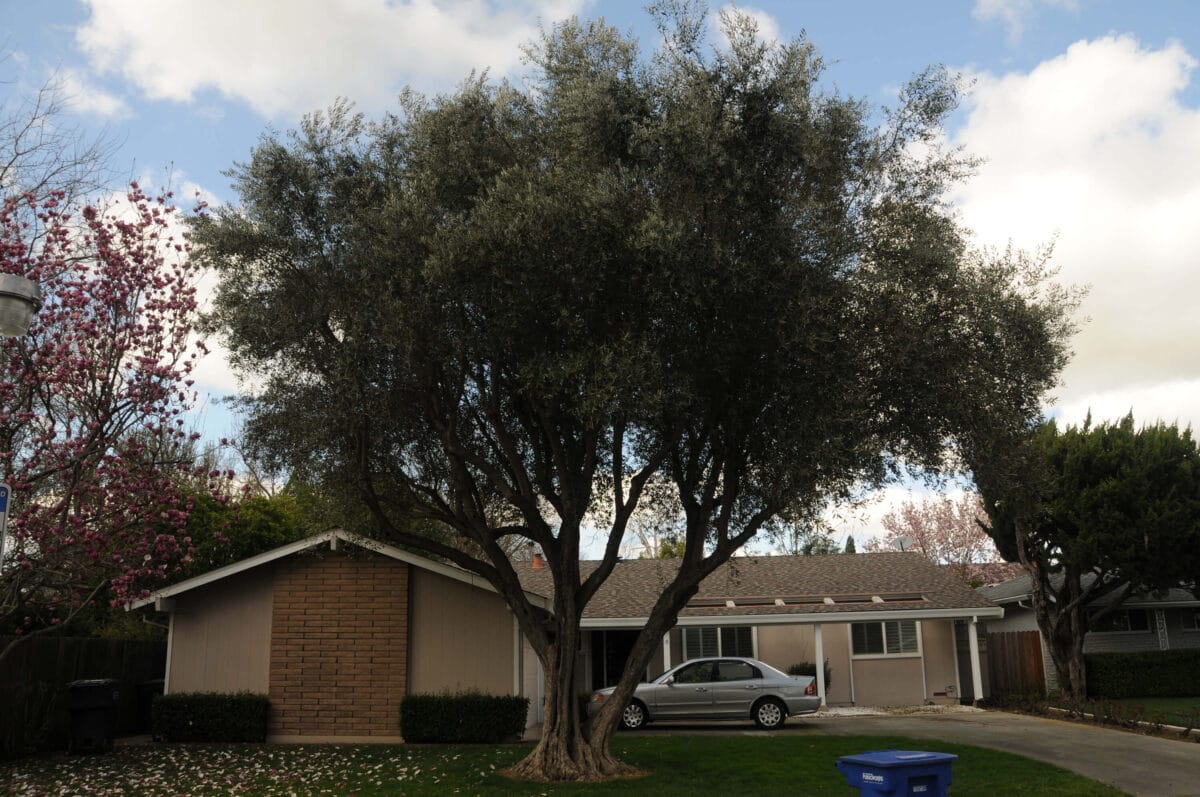
Olive trees love soaking up the sun, so make sure they get at least six hours of direct sunlight each day. They’ll grow happily in well-draining soil, reaching heights of up to 30 feet for standard varieties, while dwarf types stay small and cute, perfect for compact gardens.
One of the fantastic things about olive trees is that they’re pretty tough and can handle dry conditions, making them ideal for California’s climate. Of course, they still need some TLC, so be sure to water them regularly, especially when they’re settling into their new home and during dry spells.
To keep your tree healthy and bearing delicious fruit, give it plenty of water, but skip the organic fertilizer or soil that retains too much moisture. As they grow, their slender leaves, which come in a lovely shade of sage, create a lush canopy that’s supported by a strong, textured trunk.
European olive tree varieties like the Arbequina and Mission are perfect for oil production, while the Manzanilla tree produces those famous canned “California” black olives. Keep in mind that it usually takes about three years for olive trees to start producing a good amount of fruit, so patience is key. When your olive tree finally starts bearing fruit, the best time to harvest is in late summer or early fall, when olives are at their ripest.
USDA Zones: 6 – 8
Table of Contents
Quick Tips on Caring for Your Olive Tree

Cultivating and maintaining olive trees in a residential setting can be both rewarding and aesthetically pleasing. By adhering to the following guidelines, homeowners can ensure your olive tree is well cared for and healthy as the years go on:
Soil Selection: Olive trees prefer well-draining, loamy soil with a pH between 6.5 and 8.0. Prior to planting, it is advisable to conduct a soil test to determine pH levels and identify any necessary amendments.
Sun Exposure: Olive trees require a minimum of six hours of direct sunlight daily to thrive. When selecting a planting site, consider the tree’s long-term growth and avoid areas with excessive shade.
Irrigation: Although olive trees exhibit drought tolerance, consistent and deep watering is essential during the establishment phase and periods of prolonged dryness. Watering frequency should be adjusted based on soil moisture and climate conditions, aiming to maintain consistent soil moisture without causing waterlogging.
Pruning: Regular pruning promotes optimal tree health, productivity, and structural integrity. Remove dead, diseased, or damaged branches and selectively thin the canopy to increase air circulation and light penetration. Additionally, establish a central leader or scaffold branches to support the tree’s growth habit and shape.
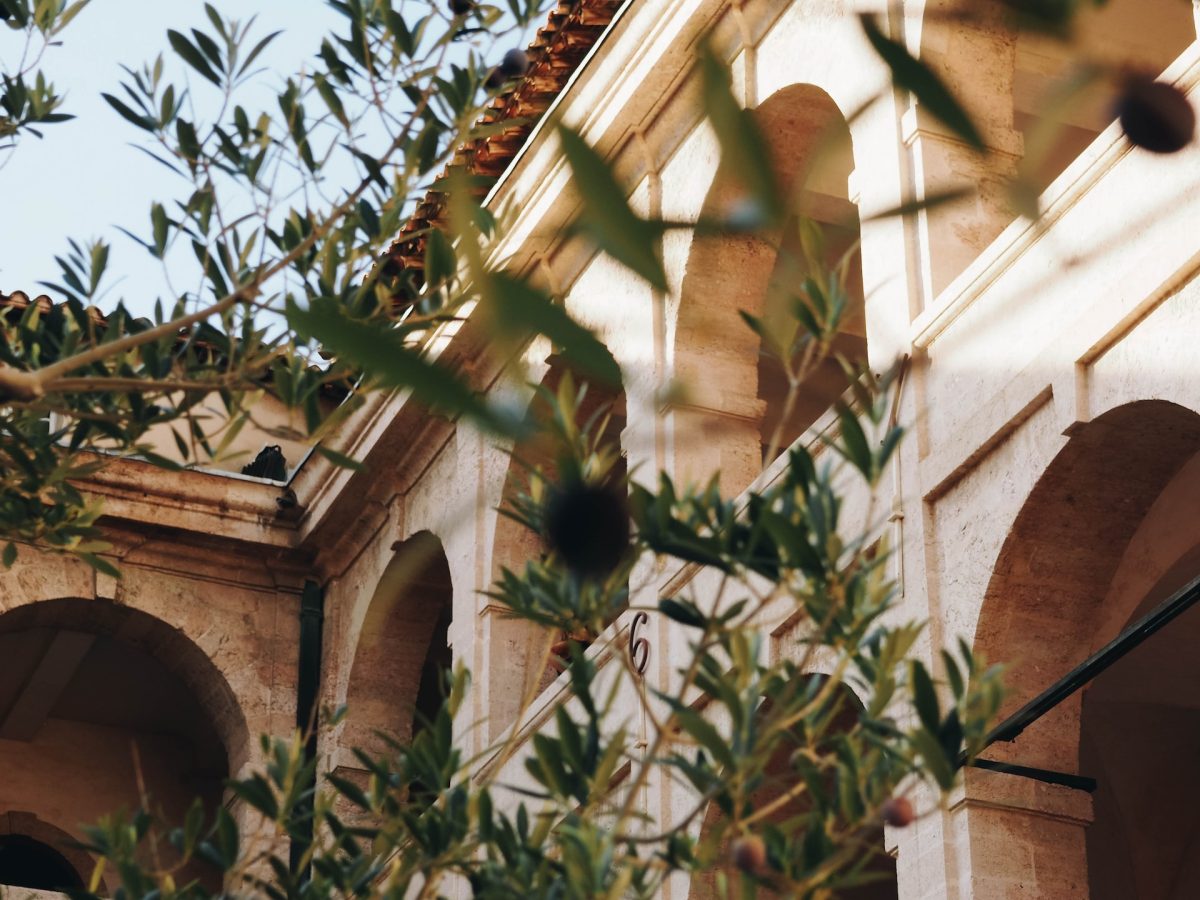
Fertilization: Olive trees have relatively low nutrient requirements; however, annual applications of a balanced, slow-release fertilizer can promote healthy growth. Conduct a soil test to determine nutrient deficiencies and consult local extension services for tailored recommendations.
Pest and Disease Management: Regular monitoring and prompt treatment of pests and diseases are vital for maintaining tree health. Common olive tree pests include scale insects, olive fruit flies, and verticillium wilt. Employ integrated pest management strategies, such as introducing beneficial insects, implementing cultural controls, and using targeted chemical treatments when necessary.
Fruit Thinning: To improve fruit quality and reduce alternate bearing, thinning may be necessary. Removing excess fruit can help redirect the tree’s energy towards the remaining olives, enhancing their size and quality.
Harvesting: To optimize fruit quality and oil content, harvest olives when they transition from green to black, typically in late summer or early autumn. Hand-picking or using a harvesting rake can minimize damage to the tree and fruit.
Pruning Your Olive Tree

The purpose of trimming olive trees is to open more of the tree up to sunshine so that the tree can flourish and potentially produce more fruit. Opening up the canopy and exposing the center growth to more light will improve fruiting, and give you a nicer looking tree in general. Olive trees grow slowly, so only occasional light pruning is needed to maintain a healthy tree.
It’s okay to prune olive trees to achieve a desired shape, but cutting new growth may affect how much fruit the tree produces. If you are starting with a young olive tree, don’t prune until it at least four years old. These first years are critical for the tree to establish itself and produce new growth. Please, step away from the shearers!
It’s a shame to see all the wonderful olive trees that have been hacked to death by unqualified trimmers. That’s why I am of the strong opinion that it’s best to leave any major pruning to a professional arborist. I do understand, however, that tree trimming services can be expensive, so if hiring a professional is not an option for you, here’s the best way to do it:
The best time to prune your olive tree is when it begins to bloom, in the spring or early summer. Wait until winter rains are over, because the open wounds from trimming will make your tree vulnerable to water-borne disease.
To help the tree produce more fruit or simply open up the canopy so inside leaves are getting enough light, carefully remove some central branches. Aside from making sure your tree is not resting on your house or low power lines, the only trimming that you should be doing is to de-crowd the center of your tree. If your tree is growing too tall, you can thin out the growth at the top, but do not hack away at major branches, as that will only promote new tall growth. Pruning the top, upwardly growing branches back a few inches will encourage more lateral growth (which is helpful when picking fruit).
After your olive tree’s structure is established, it should require very little subsequent maintenance. Below are some examples of olive trees that were not properly pruned.
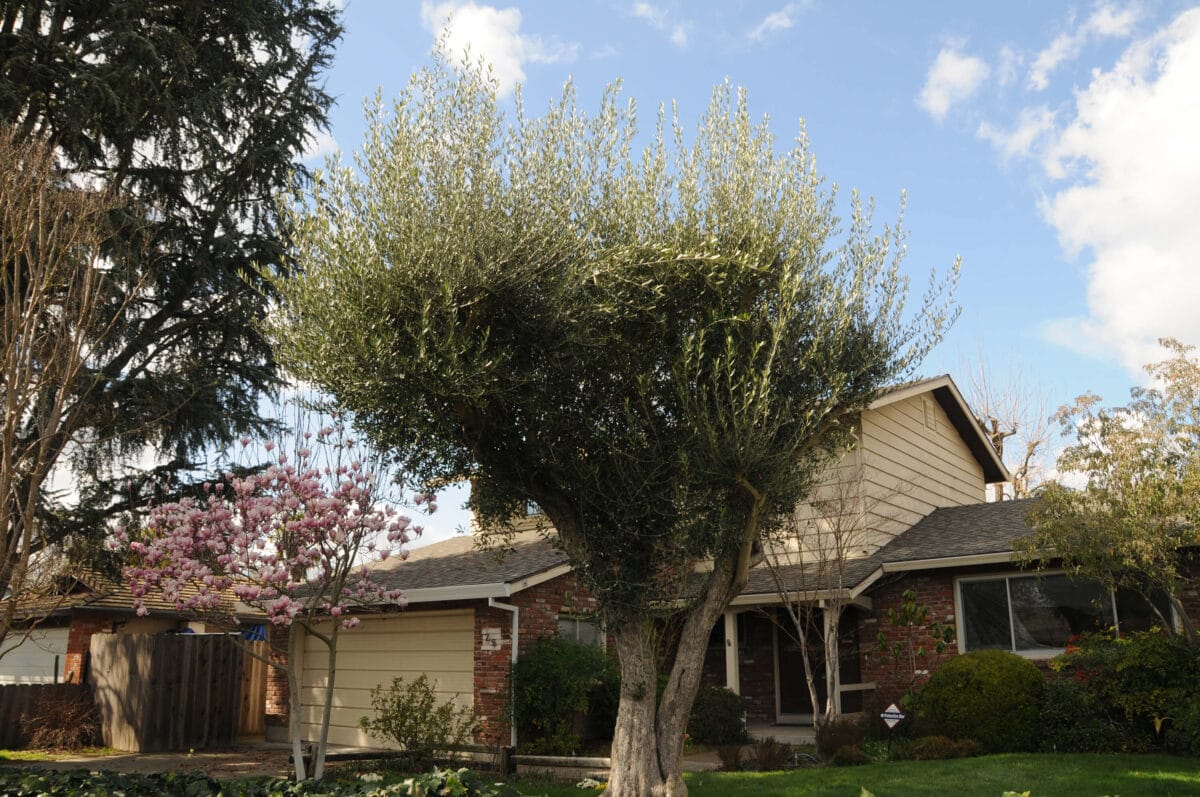
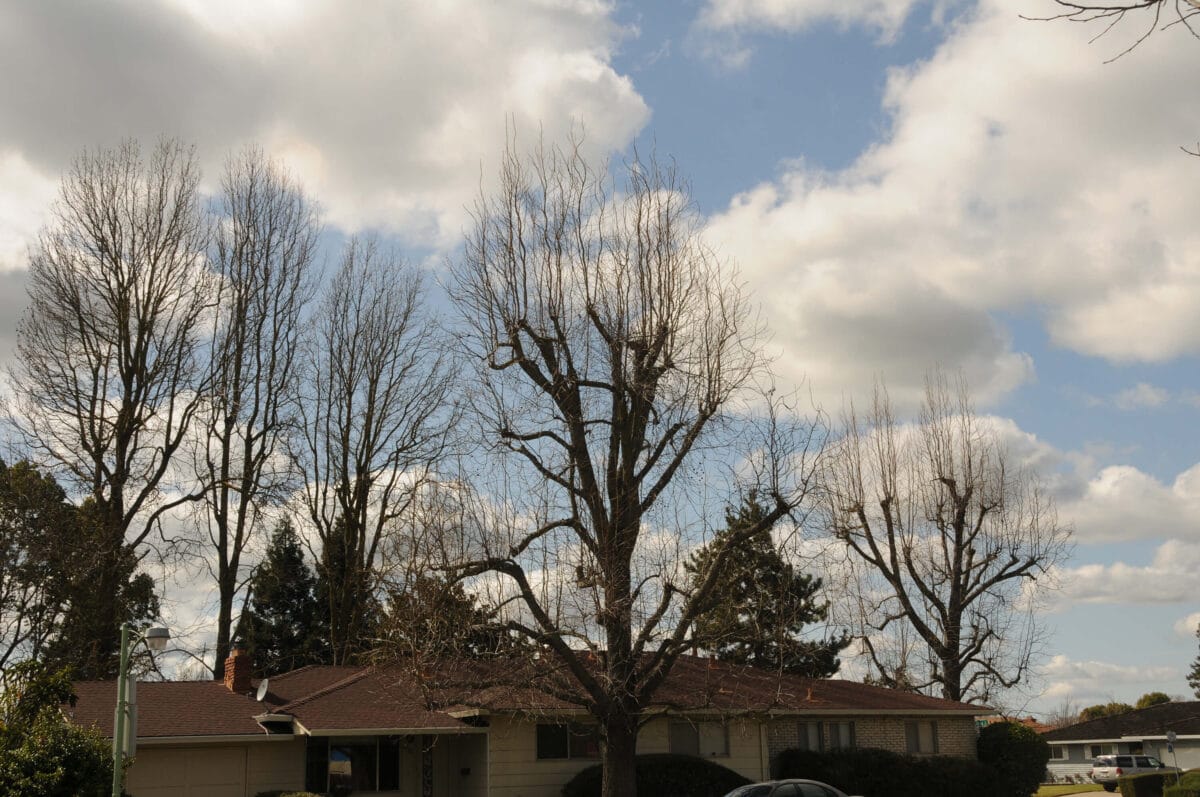
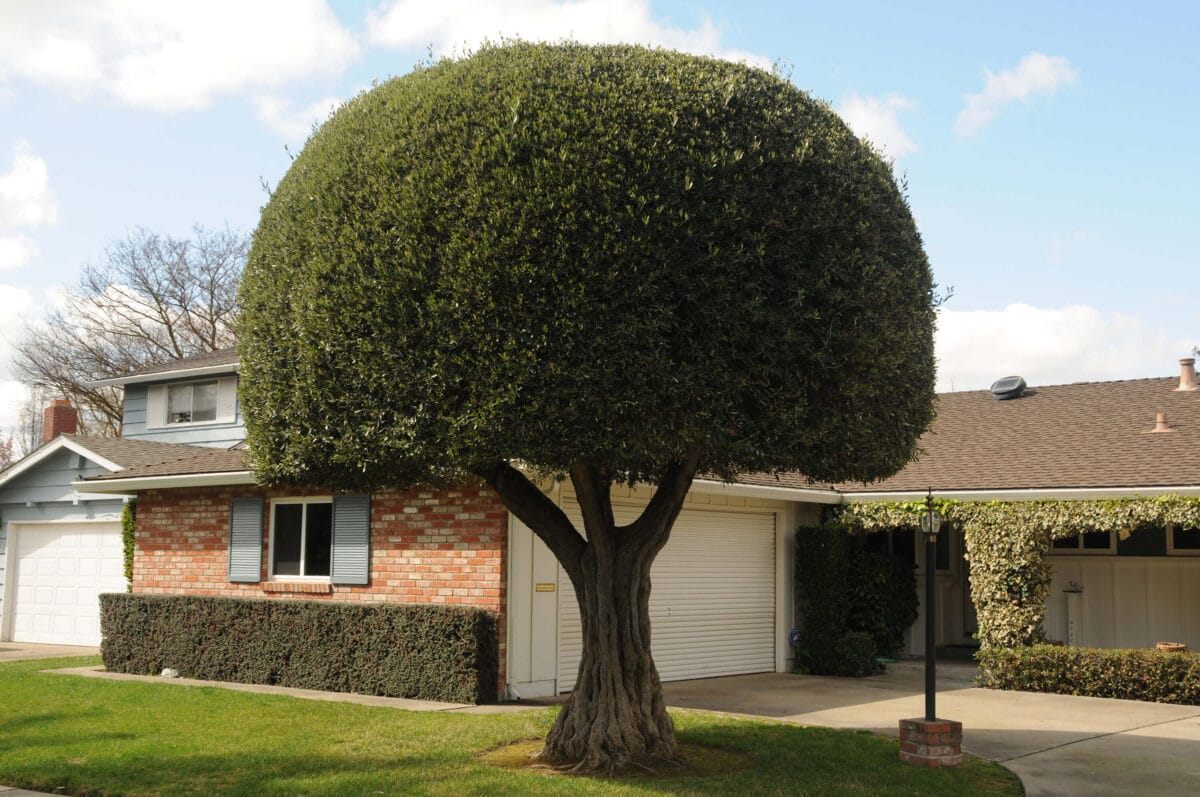
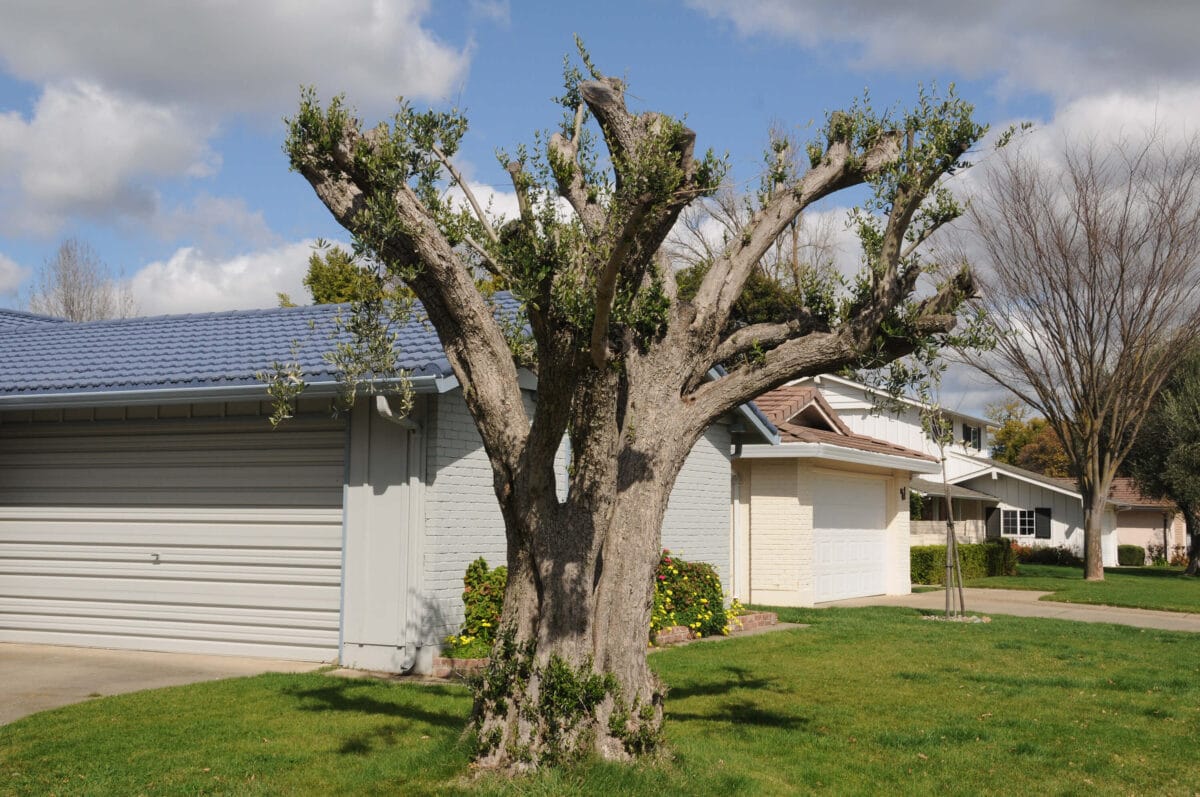
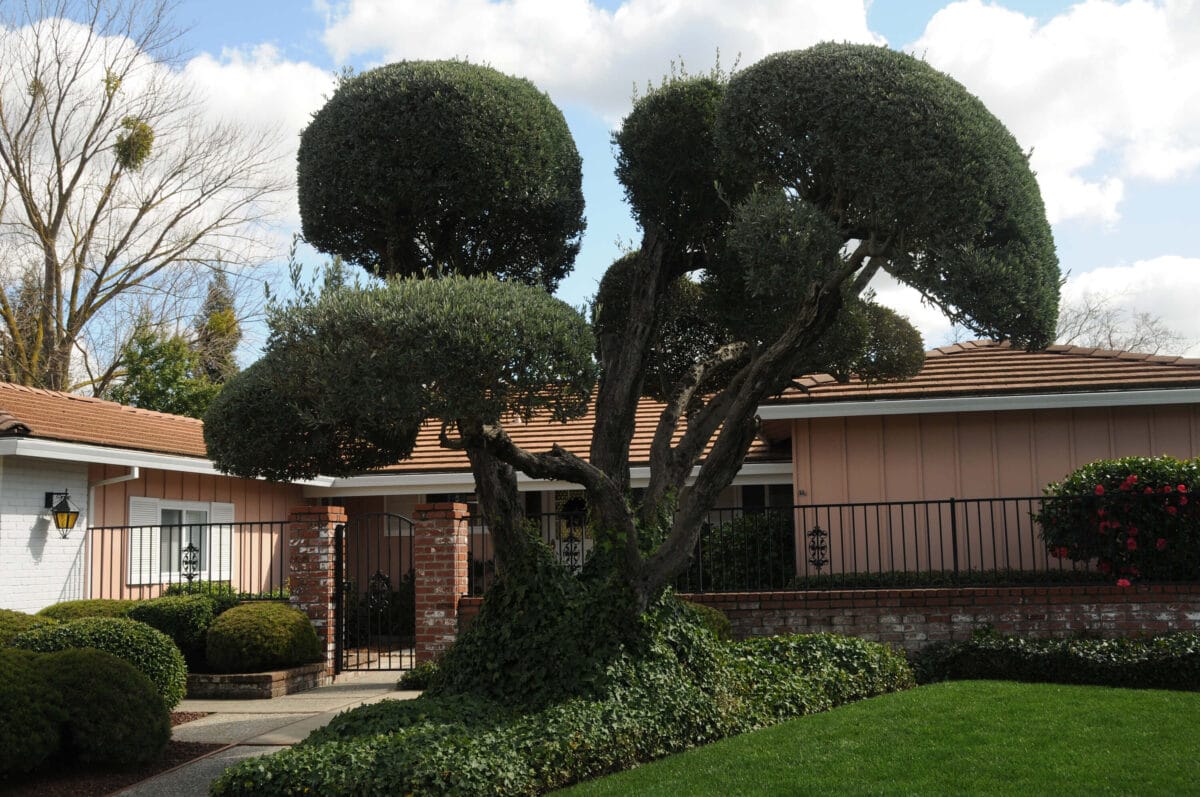
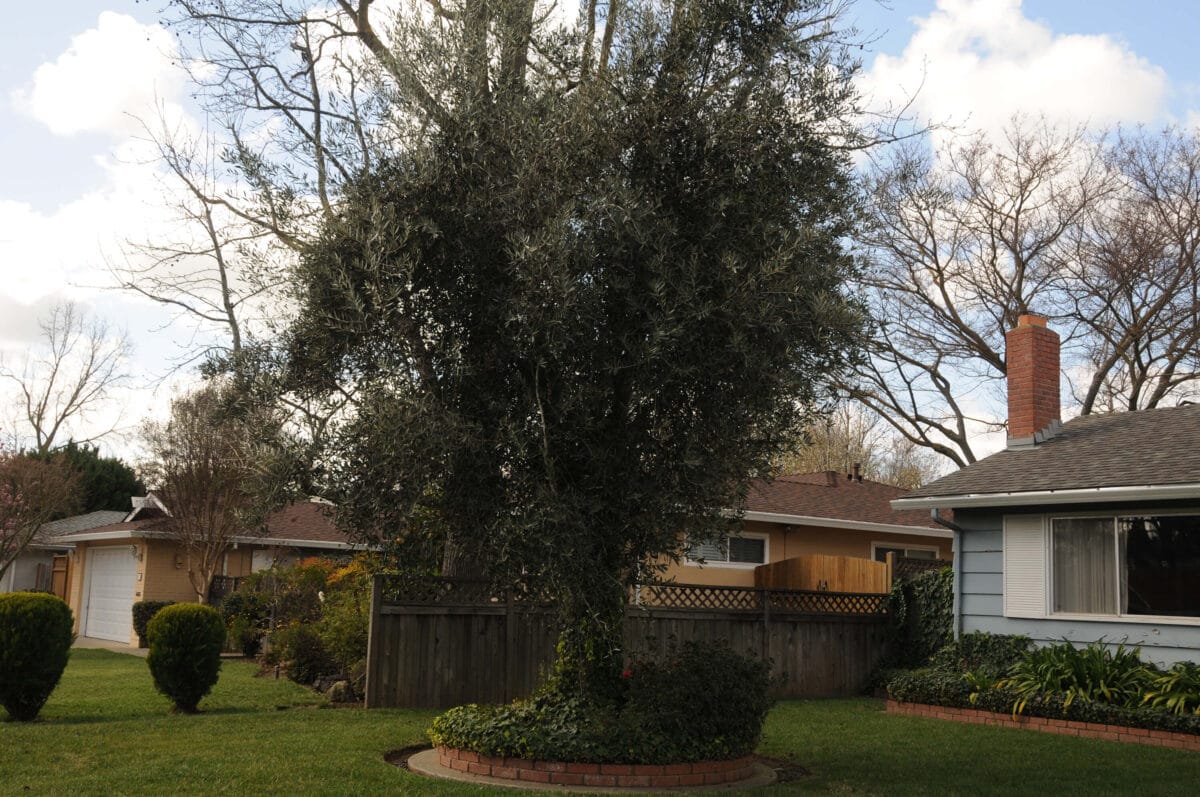
Pruning an olive tree is essential for maintaining its health, structural integrity, and productivity. Here’s a quick punch list to ensure your tree maintains its beauty.
Timing: The optimal time for pruning olive trees is during late winter or early spring, as the tree is dormant and the risk of disease transmission is minimized. Avoid pruning during periods of high humidity, as this may facilitate the spread of fungal infections.
Tools: Utilize sharp, clean, and well-maintained pruning tools, such as pruning shears, loppers, or a pruning saw, depending on the branch size. Sterilize tools with a 10% bleach solution or rubbing alcohol between cuts to prevent the spread of diseases.
Safety: When pruning larger trees or working at heights, ensure personal safety by using appropriate protective gear, including gloves, safety glasses, and a hard hat. Employ the use of a sturdy ladder or enlist the help of a professional arborist if necessary.
Pruning Objectives: Establish clear pruning objectives before beginning. Common goals include maintaining the tree’s structural integrity, promoting air circulation and light penetration, and shaping the tree for aesthetic or functional purposes.
Pruning Technique: Begin by removing dead, diseased, or damaged branches using a clean, angled cut just outside the branch collar. This facilitates the tree’s natural healing process and reduces the risk of decay.
Thinning: Selectively thin the tree’s canopy to increase air circulation and sunlight penetration, focusing on removing crossing or rubbing branches. Aim to remove no more than 25-30% of the canopy in a single pruning session to avoid placing undue stress on the tree.
Structural Pruning: Encourage a strong tree framework by establishing a central leader or scaffold branches. Remove competing leaders or branches with weak, narrow crotch angles, as these are prone to splitting under the weight of fruit or during inclement weather.
Height Management: To maintain a manageable tree height, perform reduction cuts on taller branches. Cut back to a lateral branch that is at least one-third the diameter of the removed limb, ensuring the remaining branch assumes the role of the dominant leader.
Training Young Trees: When pruning young olive trees, focus on shaping and training the tree to develop a strong, balanced framework that will support future growth and fruit production.
Post-Pruning Care: After pruning, provide appropriate care, such as watering and fertilizing, to support the tree’s recovery and encourage healthy regrowth.
Growing an Indoor Olive Tree

Many are surprised to learn that some olive trees can be grown indoors, although not indefinitely. Some speculate they will last around eight to nine years inside (which is plenty of time for me).
In the right pot, olive trees will elevate any modern interior with that quintessential Tuscan feel. Make sure you choose a dwarf olive tree, and place it in a south-facing window so it gets plenty of sun. Plant your olive tree in a larger container so its roots have plenty of room to grow, and water often. Potted olive trees will need to be watered more frequently than those planted in the ground.
While you can learn how to care for olive trees indoors, with careful planning and diligent care, it is possible to grow a thriving, appropriately sized tree.
Selection: Choose a dwarf olive tree variety, such as Olea europaea ‘Little Ollie’ or ‘Arbequina’, which are better suited for indoor environments due to their compact growth habits.
Container: Select a well-draining container with adequate drainage holes and a saucer to prevent waterlogging and protect surfaces. A pot approximately 18-24 inches in diameter is suitable for a young tree, allowing room for root growth.
Potting Mix: Utilize a well-draining, loamy potting mix, preferably with a pH between 6.5 and 8.0, to mimic the natural soil conditions preferred by olive trees. Amendments such as perlite or sand can improve drainage and aeration.
Light Exposure: Olive trees require a minimum of six hours of direct sunlight daily to thrive. Position the tree in a south-facing window or supplement natural light with a full-spectrum grow light to ensure adequate light exposure.
Watering: Consistently maintain soil moisture, allowing the top few inches of soil to dry between waterings to prevent root rot. Adjust watering frequency based on seasonal humidity and temperature fluctuations, taking care not to overwater.
Fertilization: Apply a balanced, slow-release fertilizer formulated for fruiting trees or a water-soluble fertilizer at half strength every 4-6 weeks during the growing season. Cease fertilization during winter months when the tree enters dormancy.
Humidity: Olive trees are adapted to Mediterranean climates with moderate humidity levels. To maintain adequate humidity indoors, consider using a humidifier, placing the tree on a pebble tray filled with water, or misting the foliage regularly.
Pruning: Prune the olive tree to maintain its size, shape, and structural integrity. Remove dead, diseased, or damaged branches and selectively thin the canopy to increase air circulation and light penetration. Perform pruning during late winter or early spring when the tree is dormant.
Pest Management: Regularly monitor the tree for common indoor pests such as spider mites, aphids, or scale insects. Employ integrated pest management strategies, such as manual removal, or targeted chemical treatments as necessary.
Overwintering: As indoor temperatures drop during the winter months, reduce watering and withhold fertilization to encourage dormancy. Monitor the tree for signs of stress and adjust environmental conditions as needed.
When should olive trees be pruned?
Olive trees should be pruned after winter rains, in the early spring or summer when its flower buds are beginning to open.
How much to water an olive tree?
Water olive trees regularly, especially after just being planted or during a dry spell.
How to trim an olive tree?
Thin the center of the olive tree’s canopy to allow for more light and a well structured tree. Thin some small top branches to encourage lateral growth.
Pin this!
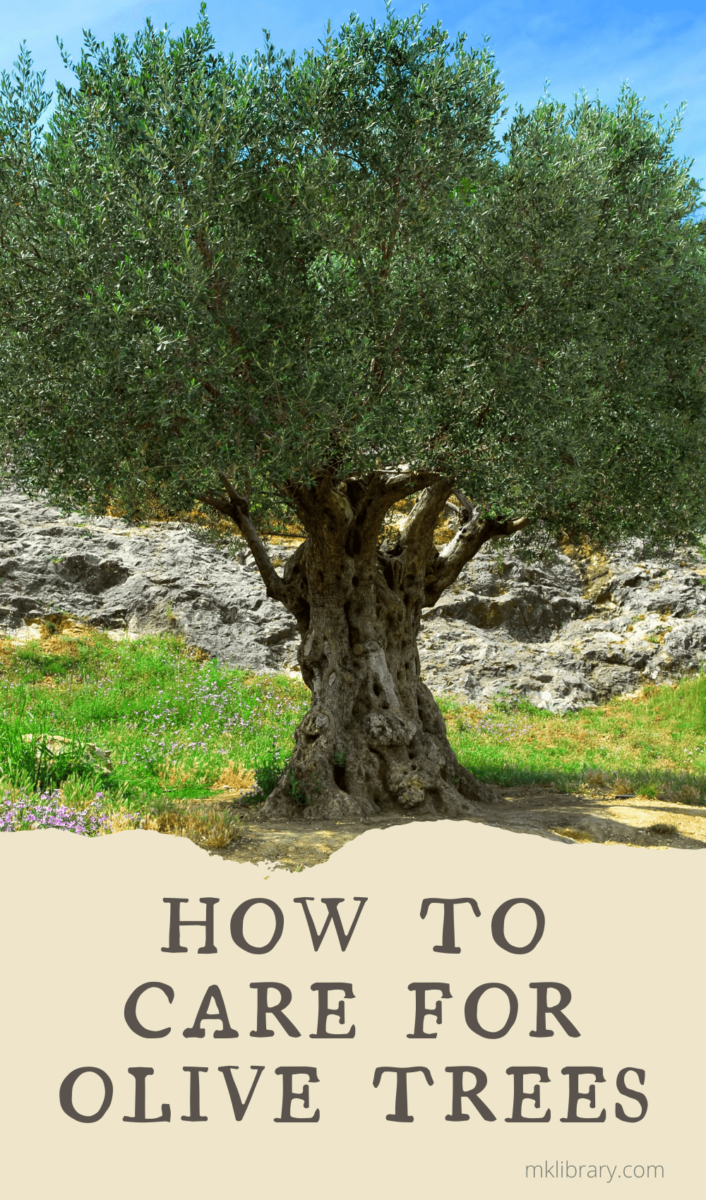
- About the Author
- Latest Posts
I strive to paint vivid landscapes with my words, bringing the magic of far-off lands and enchanting aromas to life for my readers. Combine passion for exploration and the art of gastronomy in an unending ode to the senses. When I’m not traversing the globe, I find solace in the earth beneath my fingertips, tending to my garden and working on projects around my verdant oasis. MK Library serves as a beacon, guiding fellow travelers and homebodies alike to embrace sustainability, nurturing both our planet and our souls with purpose. Full Bio.

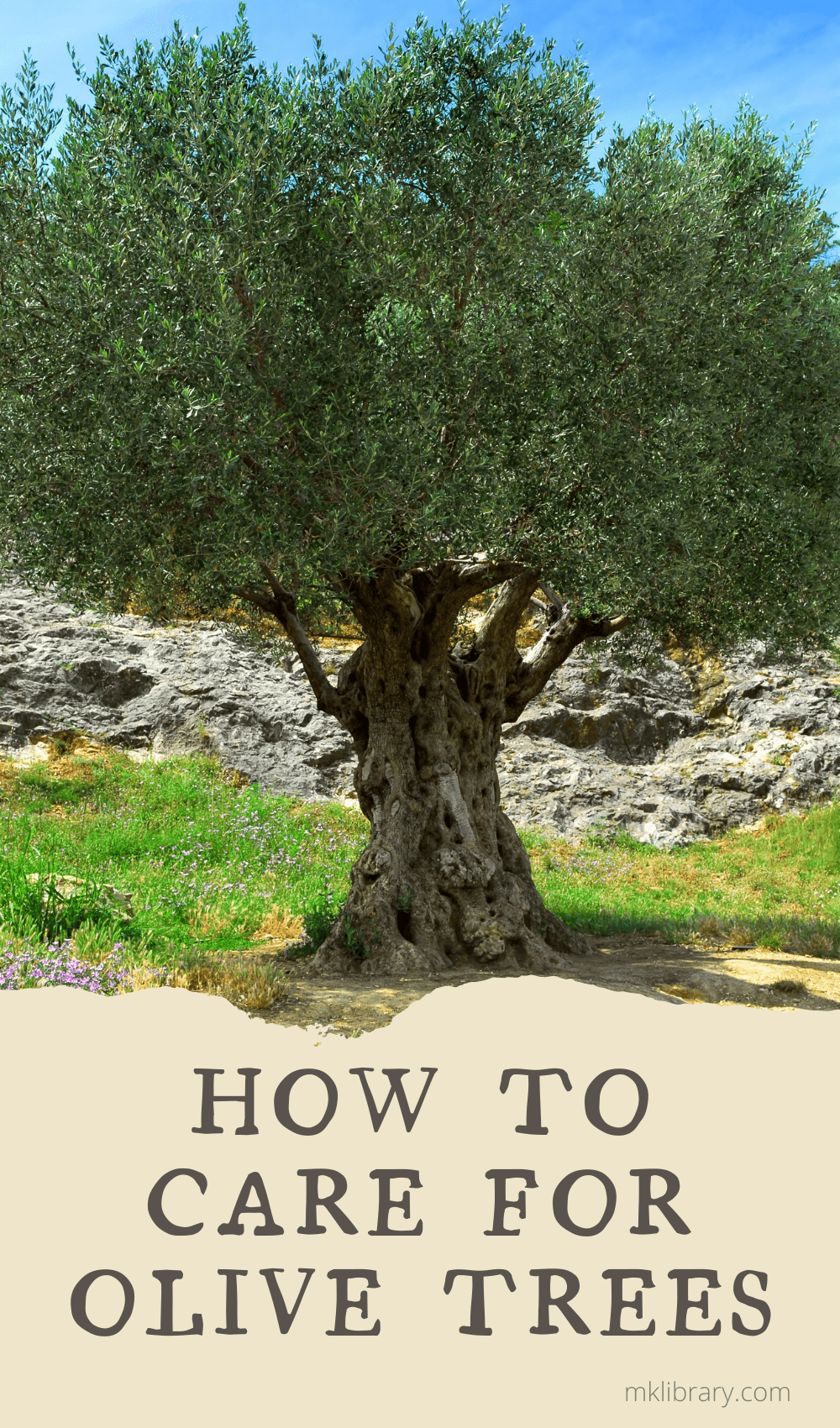

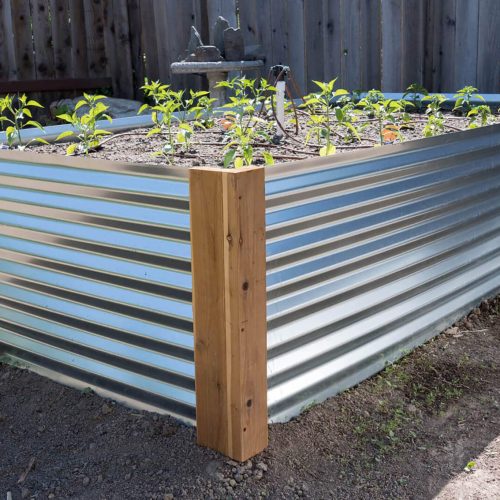

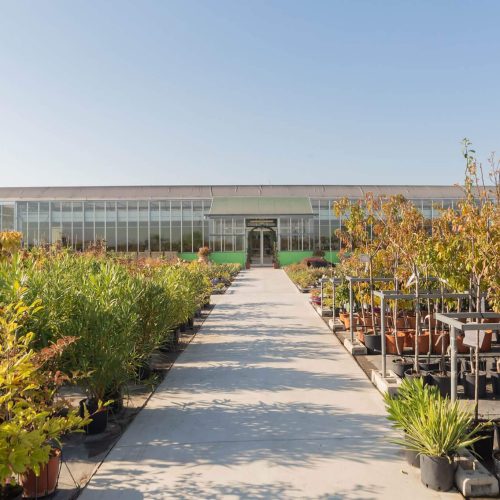
If you can put it the sleigh on your roof, that would be great.
Heavy demand sometimes results in the lawn care company taking short cuts.
that yellow spots don’t just look bad, they also could be
indicators of a fungal disease, pest infestation or poor soil quality.